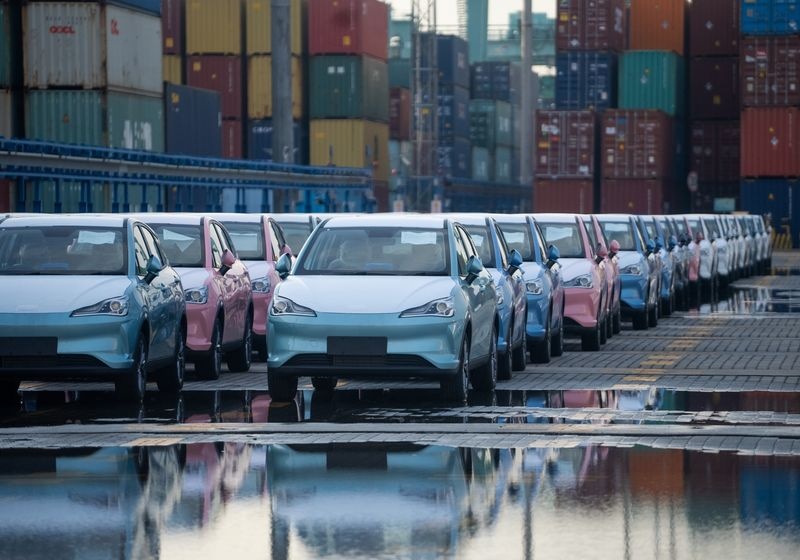
|
|
European ports are experiencing congestion, with Chinese vehicles playing a contributing role. Photo by Bloomberg. |
Financial Times reports that European ports are overwhelmed by a surge of imported cars, turning these ports into parking lots for automakers. This issue stems from a combination of limited consumer demand and logistical challenges, including a shortage of freight drivers.
According to industry experts quoted by the publication, the influx of Chinese electric vehicles is a primary cause. Some companies are delivering their products to European ports without a clear plan for subsequent transportation. Additionally, automakers are facing difficulties in booking vehicle carriers due to a lack of drivers and equipment to move cars from ports to carriers.
“Car distributors are using port parking lots as storage. Instead of delivering cars to dealerships, they are keeping them at the ports,” Financial Times quoted a representative from Port of Antwerp-Bruges, which operates one of Europe’s busiest ports, Zeebrugge.
The company also affirmed that all major European ports are grappling with a backlog of imported vehicles, without specifying the origin of these vehicles.
Citing automotive industry experts, Financial Times attributes the congestion partly to Chinese automakers’ slower-than-expected sales. Chinese electric vehicle manufacturers, according to a supply chain manager, are utilizing European ports as parking lots.
Some Chinese electric vehicles, according to industry experts, have been sitting at European ports for up to 18 months. Certain ports have requested that importers provide information on their transportation plans.
| |
|
Weak sales are a contributing factor to the large number of Chinese vehicles stranded at European ports. Photo: Car News China. |
Meanwhile, Cui Dongshu, Secretary-General of the China Passenger Car Association, acknowledged the challenges Chinese electric vehicle brands face in providing after-sales services in European markets and navigating domestic transportation within these countries.
“Chinese car companies need to improve after-sales services in Europe. We need to change the way we export cars to avoid being at a disadvantage,” remarked Cui Dongshu.
BLG Logistics, which operates at Germany’s Bremerhaven port, shared that they have had to store cars at the port for extended periods since the German government stopped providing subsidies for electric vehicle purchases in December last year.
Financial Times noted that the congestion at European ports coincides with Chinese automakers’ plans to increase exports to Europe. Companies like BYD, Great Wall Motors, Chery, and SAIC aim to maintain production at their domestic factories and take advantage of incentives offered by European countries for electric vehicles.
China’s car exports in 2023 were 58% higher than in 2022. Last year, China surpassed Japan to become the world’s largest car exporter, with over 5.22 million vehicles shipped from its ports, totaling more than USD 101.6 billion in export value.
In the first two months of this year, Belgium, the UK, Germany, and the Netherlands were the primary markets targeted by Chinese automakers for their electric, hybrid, and hydrogen-powered vehicles.
Financial Times revealed that a significant portion of the transportation capacity in Europe has been pre-booked by Tesla, making it challenging for importers of Chinese vehicles to secure alternative options for moving their cars from the ports.
Recommended Reads for Your Journey
Our Automotive section presents a selection of captivating books to accompany you on your travels. During those moments of rest and relaxation, a good book can be an engaging companion.
[CAR REVIEW] Ford Everest 2023: Dominating the segment with assurance
The Hyundai Santa Fe is dominating the 7-seater SUV segment with its strong momentum. On the other hand, the Kia Sorento is facing a decline, and Japanese models such as the Toyota Fortuner and Mazda CX-8 are also losing their foothold. Moreover, the Isuzu Mu-X is gradually fading away. In this landscape, the arrival of the Ford Everest 2023 has injected new life into the market, bringing a fresh wave of excitement.





























![[CAR REVIEW] Ford Everest 2023: Dominating the segment with assurance](https://vnauto.net/wp-content/uploads/2024/02/xehay-fordeverest-11042022-26-150x150.jpg)











